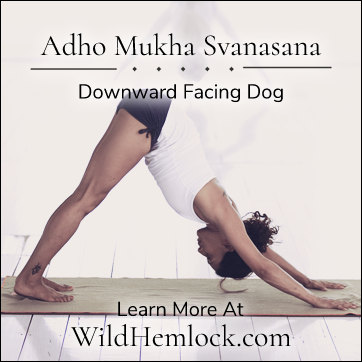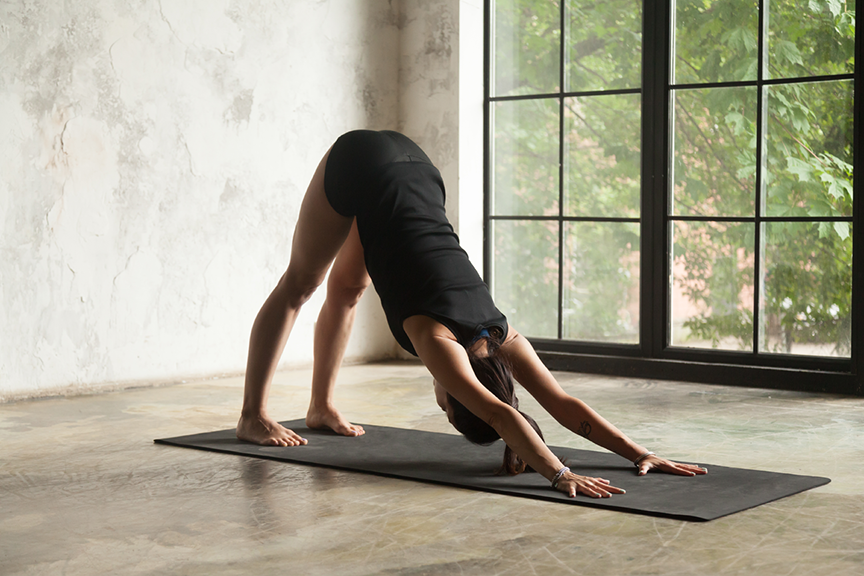
Downward Facing Dog is a beginner level foundational pose. It has been instrumental to healing my spine and reducing my painful symptoms. Of course, yoga is not for everyone and it won’t necessarily help every condition. It has helped me!
I use this pose in almost every yoga sequence that I practice. It feels like my tailbone is being released from all the pressure that is created by sitting. There are many variations to this pose, and it appears very simple. Truthfully, I cannot get my heels the entire way down to the ground yet; and I have been practicing for years. So fret not! This isn’t necessary to receive the benefits of this yoga pose.
Disclaimer: I am not a certified yoga instructor, nor am I a medical professional. Always talk to your doctor before starting any exercise regimen, especially if you have a medical condition. Proceed at your own risk.
Anatomy
Downward Facing Dog Pose is called Adho Mukha Svanasana in the Sanskrit language. It is an inversion pose, which means that the yogi’s heart is at a higher level than their head. It is also an arm support pose, which relies on upper body strength. This pose stretches muscles in the arms, legs, shoulders, abdomen, and hips [1].
To be more specific, the wrist experiences a dorsiflexion, the elbow has an extension, the shoulder goes into an flexion, the forearm has a pronation, and the shoulder blades elevate and upwardly rotate [1]. The sacroiliac joint of the spine practices a nutation, the hip has a flexion, the knee extends, and the ankle also experiences a dorsiflexion [1]. These contractions and expantions of muslces result in a neutral spine, and encourages an axial extention, or straightening of the spine [1].

Diagram from Yoga Anatomy, 2nd ed., by Leslie Kaminoff and Amy Matthews, 2017.
The promotion of axial extension is one of the most important reasons to practice Downward Facing Dog Pose – but there are many more. Calves, thighs, feet, abdominal muscles, glutes, arms, and hands all benefit from this pose. Stretching the heels of your feet to the ground produces a deep hamstring stretch [2].
Treatment and Contraindications
Adho Mukha Svanasana can be added to the treatment plan of the following disorders, after consultation with a doctor and a yoga instructor:
- Sciatica
- Flat Feet
- Back Pain
- Fatigue
- Headaches
- Insomnia
[2] [3] [4]
According to the European Journal of Integrative Medicine, yoga (specifically including Downward Facing Dog) reduced both stress and inflammation biomarkers in a controlled study. It also helped with chronic low back pain and spine flexibility [6].
There are also many contraindications, which means that if you are currently experiencing any of these, you should avoid doing Downward Facing Dog:
- Diarrhea
- Carpal Tunnel
- High Blood Pressure
- Acute Headache
- Arthritis in Wrist
- Arthritis in Elbow*
- Pregnancy
[2] [3] [4]
* Note, I find this helps my arthritic elbow. Your experience may vary.

Downward Facing Dog
Directions
1. Start in Table Pose. This means “down on all fours”, or with your hands and knees on the ground, with your arms directly below your shoulders and your knees directly below your hips.
Keeping your arms and legs at shoulder and hip width is very important!
2. Tuck your toes under your feet. This creates a right triangle between your shinbone, your foot, and the floor with your toes facing forward.
3. Spread your fingers, and drive the palm of your hand into the ground. Your hands should be facing forward.
4. Exhale, contract your abdominal muscles, lift your knees off of the ground, and come up onto the balls of your feet. Straighten your legs without locking your knees.
5. Stretch your arms out straight, without locking your elbows. Create a straight, sloping angle with your back so that your neck is a continuation of your spine.
Your ears should be between your biceps and the inside of your elbows should be facing each other.
6. Relax your shoulders down away from your ears, so that your shoulders are parallel with the ground.
7. Square your hips, so that they are also parallel with the ground.
8. Keeping your heels up, ease one of them down to the ground, feeling the hamstring stretch. Repeat on the other side.
9. Stretch down with your feet and hands, creating an isosceles triangle with your body and the floor.
10. Breath! Breath in and out for five breaths or longer.
[2] [3] [4] [5]
Variations & Associated Poses
There are many variations to explore! Downward Facing Dog Split, Downward Facing Dog Twist, Dolphin Pose, Downward Facing Dog with Scorpion Leg, Knee to Nose Pose, or even Downward Dog Dancer.
Preparatory poses include Forward Bend, Plank Pose, and Mountain Pose [2][4].
You can follow Downward Facing Dog with many poses, such as Child’s Pose, Warrior 1, Crescent Lunge, Pigeon, Half Split, Extended Side Angle, and more. This pose is a great transition pose between standing poses or sitting poses.
Do you like WildHemlock.Com?
Support with Paypal!
Sources:
- Kaminoff, Leslie, and Amy Matthews. Yoga Anatomy. 2nd ed., Human Kinetics, 2017.
- “Downward-Facing Dog.” Yoga Journal, 28 Aug. 2007, <https://www.yogajournal.com/poses/downward-facing-dog>
- “Downward-Facing Dog Pose.” Yogapedia.com, Yogapedia, Inc, <https://www.yogapedia.com/yoga-poses/downward-facing-dog-pose/11/9921>
- “Adho Mukha Svanasana: The Downward-Facing Dog Pose.” Gaia, 27 Sept. 2016, <https://www.gaia.com/article/downward-facing-dog-pose-adho-mukha-svanasana>
- August, Ashton. “The Secret to a Perfect Downward Dog and Plank Pose (Hint: It’s All About Alignment!).” YogiApproved, 13 Mar. 2018, <https://www.yogiapproved.com/yoga/down-dog-and-plank-pose/>
- Cho, Hye Kyung, et al. “Effects of Yoga on Stress and Inflammatory Factors in Patients with Chronic Low Back Pain: A Non-Randomized Controlled Study.” European Journal of Integrative Medicine, vol. 7, no. 2, Apr. 2015, pp. 118–123., <https://www.sciencedirect.com/science/article/abs/pii/S1876382014003114>

